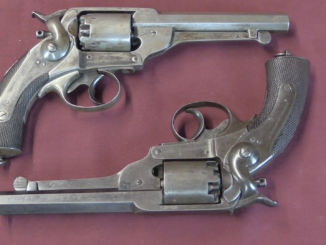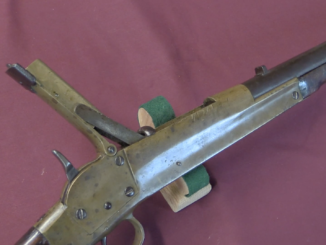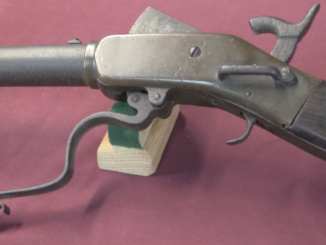During the Civil War, the Confederacy was perpetually in serious need of armaments, as the South did not have the amount of industrial infrastructure that the North did. This led to many attempts at arms production by various entrepreneurs, of quite varied result. One of the more successful enterprises was the Robinson Arms Manufactory, founded in Richmond VA in December of 1862. Samuel Robinson was a transplanted Connecticut industrialist who proved himself capable and reliable for the CSA government with a series of contracts to convert flintlock muskets to percussion ignition. Probably because of this, it was he that the CSA’s Colonel Burton turned to to set up production of a copy of the Sharps carbine for Confederate cavalry use.
Robinson produced about 1900 of these carbines between December 1862 and March of 1863. His work was impressive enough that in March of 1863 the Confederate government decided to buy out his operation and make it into a government run arsenal. They continued to make Sharps carbines there until the end of the war, producing an additional 3500 or so. These later Confederate production guns have serial numbers between about 1900 and about 5500, along with unmarked lock plates – Robinson’s guns have his company name and the date 1862 marked on the lock plates, along with serial numbers up to about 1900.




Even if Robinson’s carbine was good, what about ammunition procurement? I was under the impression that the Confederates weren’t exactly in good supply of percussion caps…
Their main problem was a shortage of mercury, the element (symbol Hg, atomic number 80, atomic weight 200.592, only metallic element normally liquid at room temperature), to make the mercury fulminate from. This affected the Union as well.
In the 1860s, the primary sources of mercury in the continental United States were the California gold mining industry and the early placer mining industry in the Nevada territory. Mercury in elemental form (aggregate) was found in the same strata as gold and had to be separated during the refining process. Before the war it was mostly disposed of in tailing piles and contaminated ground water as a result. Interestingly, most mercury used for fulminate manufacture at that time came from Sweden and what later became Czechoslovakia.
The standard filling for U.S. issue percussion musket caps in 1860 was originally 1/2 grain of fulminate, but by 1864 that was replaced by 1/4 grain plus 1/2 grain of saltpeter (potassium nitrate) to economize on the fulminate.
The Confederates were even more hard-pressed on that count, and by 1862 had given up on mercuric priming entirely. They went back to Joshua Shaw’s original percussion priming formula of 1820, consisting of 50% potassium chlorate, 30% antimony sulfate, and 20% pulverized glass/silica to ensure sufficient friction for ignition. Potassium chlorate (native saltpeter) was hard to come by, but it was still easier to obtain than mercury. This was the standard priming mix for Confederate percussion caps in everything from revolvers and muskets to artillery shells and land mines.
By the way, regarding priming, one small correction. To my knowledge, the Sharps carbine never used the Maynard tape primer. Instead, the Model 1859 introduced the Lawrence pellet primer system, that used a springloaded tubular magazine in front of the hammer to feed primer “discs” to the nipple literally as the hammer was falling;
http://www.berdansharpshooters.com/LawrencePelletPrimerSystem.pdf
The Maynard tape primer was used on prewar Maynard carbines, many of which were used by the CSA cavalry.
The prewar model looked like this;
https://www.ortnergraphics.com/img/services/HistoricalDocument/maynard-cartridge.jpg
Note the cast-brass buttplate, the tangent rear sight, and the tape primer “door” in the receiver.
By comparison, the Second Model 1863 Maynard that was used by Union cavalry looked like this;
https://www.aaawt.com/html/firearms/images/Maynard-Carbine,-2nd-Model_facing-right_728-19.jpg
Note the stamped iron buttplate, the flipover (100 yard/200 yard) rear sight on the barrel, and the lack of any tape primer. Obviously a wartime “emergency” weapon.
Incidentally, here’s a nice article on the Maynard and its primer system;
https://www.ortnergraphics.com/services/civil-war-firearms/maynard-carbine.html
One Southerner early on said, “Nothing to do with Maynard but load her up, point her north, and turn her loose. If a hundred of ’em don’t clean out all of Yankeedom then I’m a liar”.
Well, guess what?
😉
cheers
eon
Prior to model 1859, Sharps rifles and carbines used Maynard tape primer.
This type of primer was somewhat popular until its use on US models of 1855 revealed its shortcomings.
And then there is the story of a Grizzly bear that got into an army camp during WW2. Dropped with one shot from an M1 carbine. My dad also served is WW2 aviation engineers. He told me the story of the time his unit was strafed by a jap plane on nearly a daily basis. One day, as usual they fired at it with their carbines but this time it started smoking and crashed. The reality of the M1 Carbine is that it is more powerful than many pistols and a good PDW but no substitute for a battle rifle. No handgun round can do that and the M1 carbine is basically a pistol caliber carbine. What amazes me is that some of the same people who talk about how weak the .30 carbine is will talk about how powerful the .357 Magnum is..
My father has a sharpes rifle that states two different dates and we cannot find a serial number. The plate directly behind the firing lever states “C SHARPES PAT OCT. 5th 1852. The other side on the breach states “C SHARPES PAT SEPT. 12th 1848. Question: where do we find the model number and how do we determine specific sharpes rifle? Thanks
Interesting fact-Mr. Gatling was actually a North Carolina native who had moved to NY before the War. He developed his Gatling Gun during the conflict and offered it to Lincoln, but the Union never really adopted it until afterward. I’ve long wondered how the War might have differed had Gatling still been in NC and had adhered to the South.